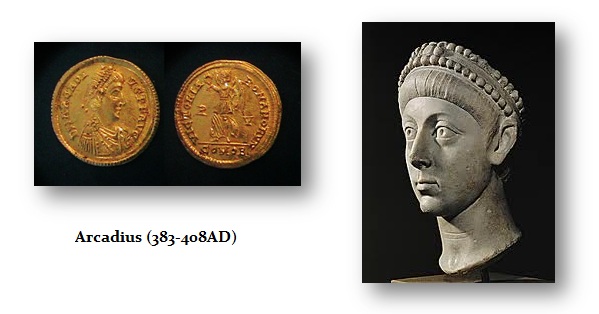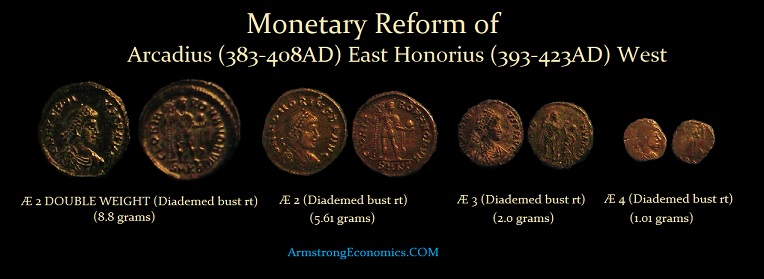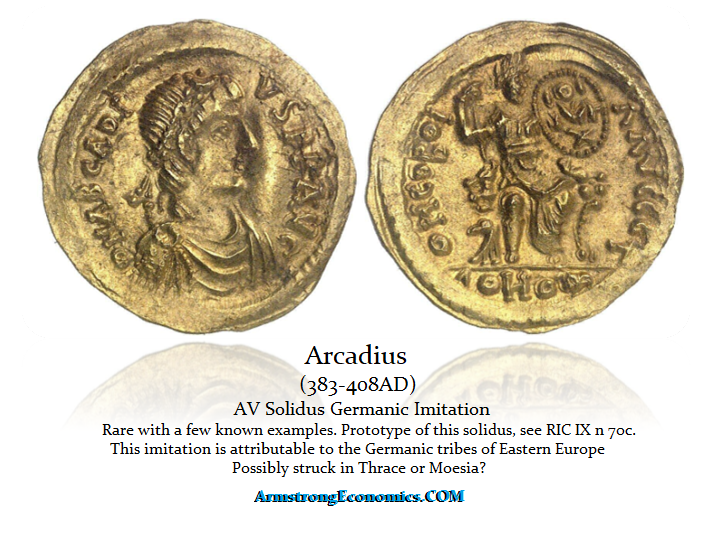Arcadius
383-408 AD
Flavius Arcadius is the eldest son of Theodosius I (379-395 AD) and Aelia Flaccilla. He was born in 377 AD and was raised to the rank of Augustus by his father in 383 AD. His first true encounter with power came when his father marched against Arbogastes in 394 AD.
Theodosius died in 395 AD, and the Empire was divided between his two sons, Arcadius taking the Eastern division and Honorius the Western. The imperial brothers had inherited none of their father’s great abilities, and in consequence, both were constantly under the influence of the strong personalities at court among their ministers.
The real power on the throne arrived in 399 AD – Eudoxia, Arcadius’ wife. It was Eudoxia who ruled from the throne with an iron fist. Anyone who dared to confront her found himself stripped of all rank and privileges and usually exiled.
When Eudoxia died in 404 AD, Arcadius turned to his Praetorian Prefect, Anthemius. This may have been one of the Emperor’s wisest moves because Anthemius was genuinely concerned about preserving the Empire. When Arcadius finally died in 408 AD, Anthemius ensured a peaceful transition of the throne to Arcadius‘ 7-year-old son – Theodosius II.
Monetary System
Mints: Alexandria, Antioch, Arelate, Aquileia, Constantinople, Cyzicus, Heraclea, Lugdunum, Milan, Rome, Siscia, Sirmium, Thessalonica, Treveri
Obverse Legends:
D N ARCADIVS P F AVG
The Monetary Reform of the Bronze Coinage
In 379 AD, Gratian (367-383 AD) introduced the tiny AE4 bronze once again with a 15mm diameter or less at a weight of slightly under 2 grams. It would appear that this new bronze denomination merely complemented those already in circulation. It is possible that the AE4 denomination was called the numus. The average weights and relationships of the bronze coinage during this period in time are provided in the table that follows:
AE1 Double Centenionalis (11.5-12 grams)
AE2 Centenionalis (4.5-5.2 grams)
AE3 ½ Centenionalis (2.3-3.56 grams)
AE4 ¼ Centenionalis (1.49-1.9 grams)
Hoard evidence suggests that the AE3 was by far the most common bronze denomination. This reform of Gratian prevailed for the most part until the bronze reform of Theodosius I (379-395 AD). However, following his death, while the denominations remained constant, the weights were reduced to AE4 and tended to decline, dropping to about 1.13 grams, generally between 383-386 AD.
In 378 AD, the joint emperor of the East, Valens (364-378 AD), met his death at the battle of Hadrianopolis at the hand of the Goths. Gratian had little choice but to turn to a famous general, Theodosius I, who was thus elevated to the vacant Eastern throne in January 379 AD, about five months after the death of Emperor Valens.
The Gothic invasions appear to have had a fairly major impact on the monetary system of the Roman Empire at this period in time. The bronze coinage appears to disappear, leaving, for the most part, only the tiny AE4 numus. We see some periodic issues of AE2 and AE3 denominations, but the large AE1 Double-Centenionalis was not issued again until the monetary reform of 475 AD under the emperor Zeno (474-491 AD). The introduction of smaller gold coinage and the disappearance and/or reduction in bronze coinage output reflects the scarcity of money following the Gothic invasions.
DENOMINATIONS
AU Solidus (4.50 grams)
AU Semissis (2.25 grams)
AU 1.5 Scripulum (1.65 grams)
AU Tremissis (1.45 grams)
AR 3 Miliarense (13.50 grams)
AR Miliarense (4.50 grams)
AR Reduced Siliqua (2.25 grams)
AR 1/2 Siliqua (1.12 grams)
AE2 DOUBLE Centenionalis (8.8 grams)
AE2 Centenionalis (4.5-5.6 grams)
AE3 ½ Centenionalis (2.0-2.5 grams)
AE4 ¼ Centenionalis (1.0-1.49 grams)
Germanic Barbarous Imitations
This is an exceptionally rare Germanic gold solidus of which perhaps less than five are known. The prototype of this solidus is an imitation of Arcadius and is certainly attributable to the Germanic tribes of Eastern Europe, with a possible strike in Thrace or Moesia.
AV Solidus








